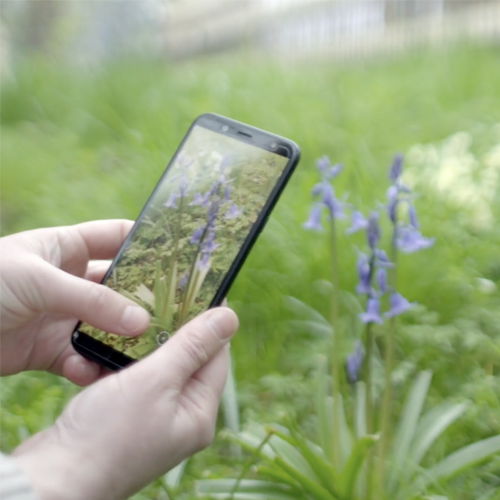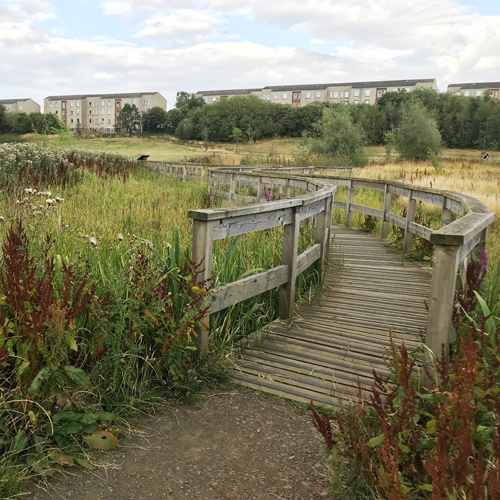How biodiverse is your park? Citizen scientists to find the answer
A collaboration between University researchers and local organisations will encourage members of the public to discover and record biodiversity in an Edinburgh park.
The new project "How Biodiverse is Your Park?", will give local people the opportunity to find, photograph and identify plants and animals in Hailes Quarry Park, Wester Hailes. This data will be collected to map local biodiversity which will help to inform improvements to parks.
Three project partners besides the University of Edinburgh will deliver the project:
- People Know How
- City of Edinburgh Council
- a local "Friends of the Park" group
The project is funded by the Natural Environment Research Council (NERC) and runs from July 2022 to February 2023.
Recording and mapping species
Easy-to-use apps

People living in Edinburgh will discover local biodiversity with the help of two easy-to-use phone apps: iNaturalist, and a Green Infrastructure Mapping app developed by EDINA at the University of Edinburgh.
Researchers will guide local organisations and members of the public to use these apps. They will photograph, identify, record, and then share information on the species they find, such as flowers, fungi, insects, and birds.
Nature maps
The focus of the project will be Hailes Quarry Park in Wester Hailes. A data mapping workshop will let participants see and interpret their collected data. A clearer understanding of hot and cold spots in Edinburgh will help future greenspace management.
The main aim of the project is to develop new ways to engage the public with environmental science. This is to support them as leaders to advocate for future improvements to their park and beyond.
Improvements could mean linking up different areas to help species move. Or boosting the quality of habitats to help nature thrive.
Building on previous work
The project is led by Elizabeth Vander Meer and Kim Vender (Social Responsibility and Sustainability). The academic lead is Professor Graham Stone (School of Biological Sciences).
The project follows on from work to develop and use an urban Green/Blue Infrastructure (GI) mapping app. The work was started by the University of Edinburgh and the City of Edinburgh Council.
It also builds on previous engagement in Wester Hailes.
Biodiversity can seem an abstract idea – and one of the best ways to get to grips with it is come face to face with nature in your local park. Measuring biodiversity means identifying organisms and describing where they are, and this can also seem very challenging. We hope that the phone apps we are training ‘citizen scientists’ how to use in this project will make both of these steps accessible and fun for anyone with an interest in nature.
Why biodiversity matters

Arguably, the life we share our world with deserves a satisfying existence, regardless of its benefits to humanity.
Yet, the web of life is an important piece of our environment that provides many “ecosystem services” that we rely on as a society. Trees help manage water movement, pollinators help provide our food, and green spaces soothe our minds, to name a few.
Connecting to nature
Local people will:
- develop valuable digital and surveying skills
- get to know their local area in a new way
- and contribute to the future of their green spaces.
We will focus on areas of the community where biodiversity engagement has been challenging. We commit to training ”super citizen scientists” beyond the funded grant period.
Through this project, University researchers will build skills in mixed environmental and social science methods. This includes phone apps alongside focus groups and surveys.
The project will also give researchers the opportunity to practise effective communication and collaboration with non-technical audiences.
Feedback on the University-designed app will make it more user-friendly in the future.
By getting involved in this work people are not only helping to respond to the biodiversity crisis but also benefit their own wellbeing by connecting with nature. We’re really excited to see this project happening in our greenspaces and look forward to making use of the information coming out of it.
As a social innovation charity People Know How is very excited to be working on this innovative project, growing roots in local communities by creating ‘Citizen Scientists’ amongst children and adults! Our children and young people’s service Positive Transitions supports young people to feel valued and understood so they can enjoy learning and discovering new talents and hobbies.
Take part
If you live in the Wester Hailes area, and are interested in taking part in this project, please email SRS.Department@ed.ac.uk
Separate to this project, anyone can become a citizen scientist. Download the iNaturalist app to start tracking the wildlife you see. Scientists around the world can access this data to assist in their research. For example, to track how species are migrating due to global heating.
Find out more
Biodiversity at the University

